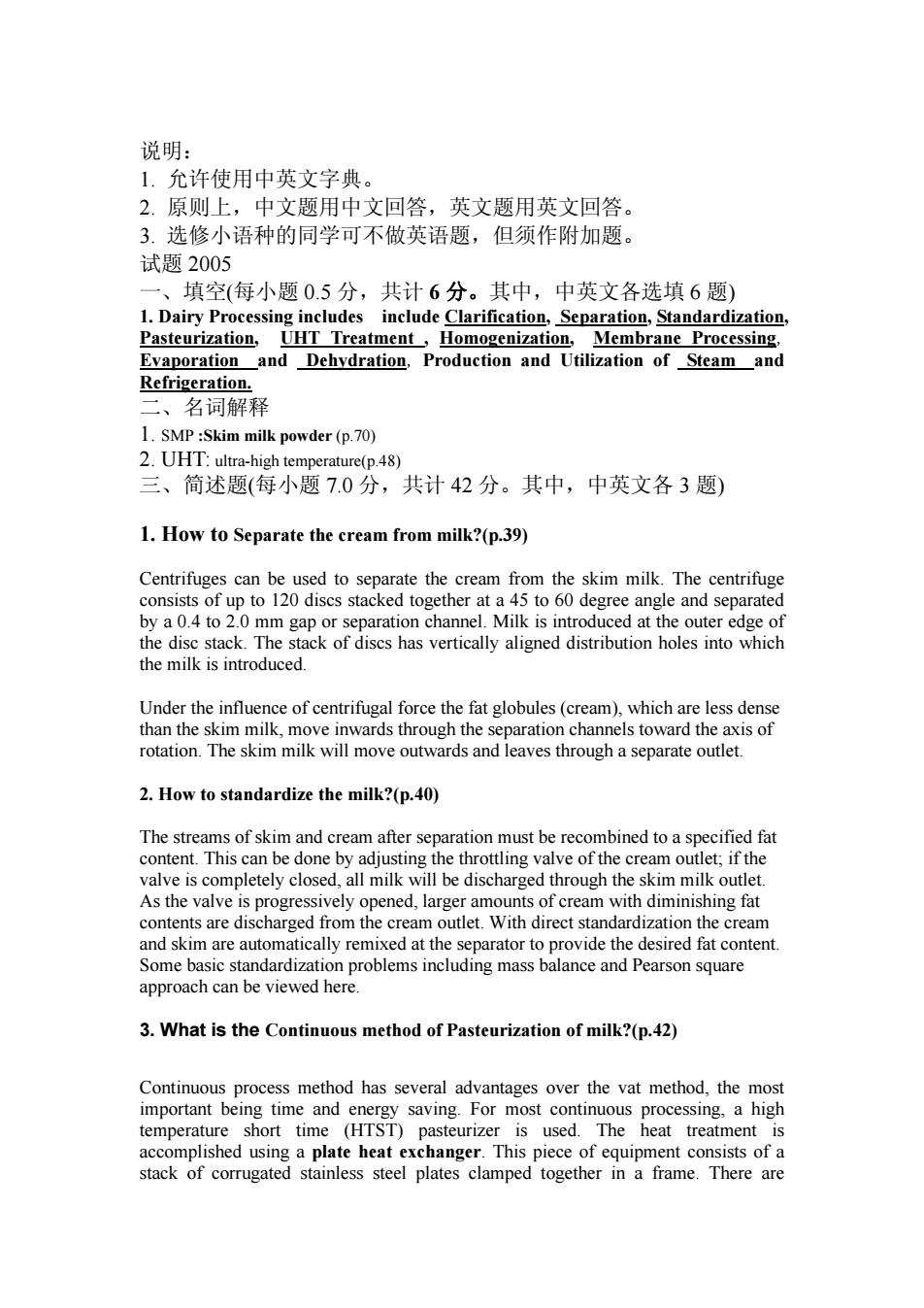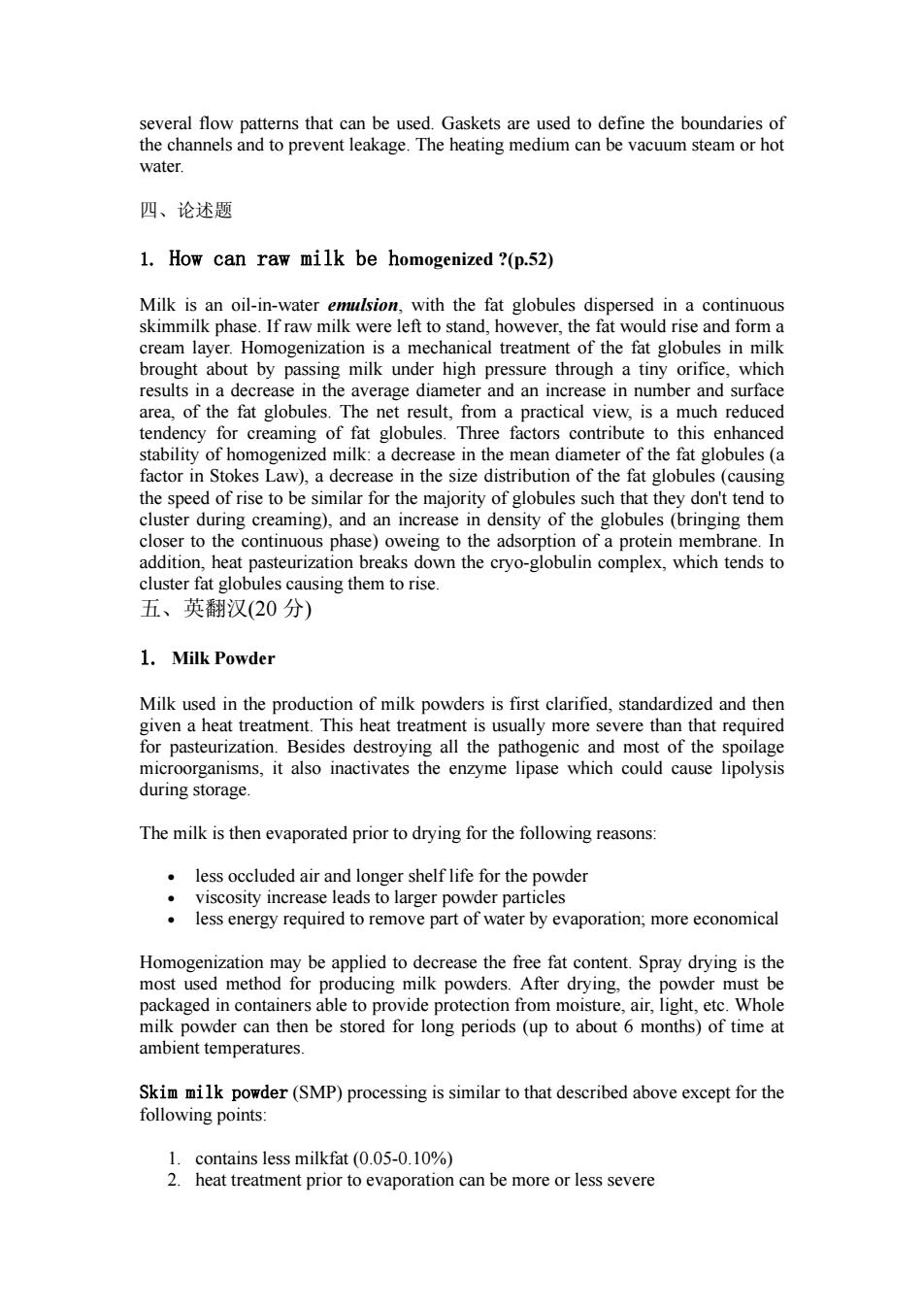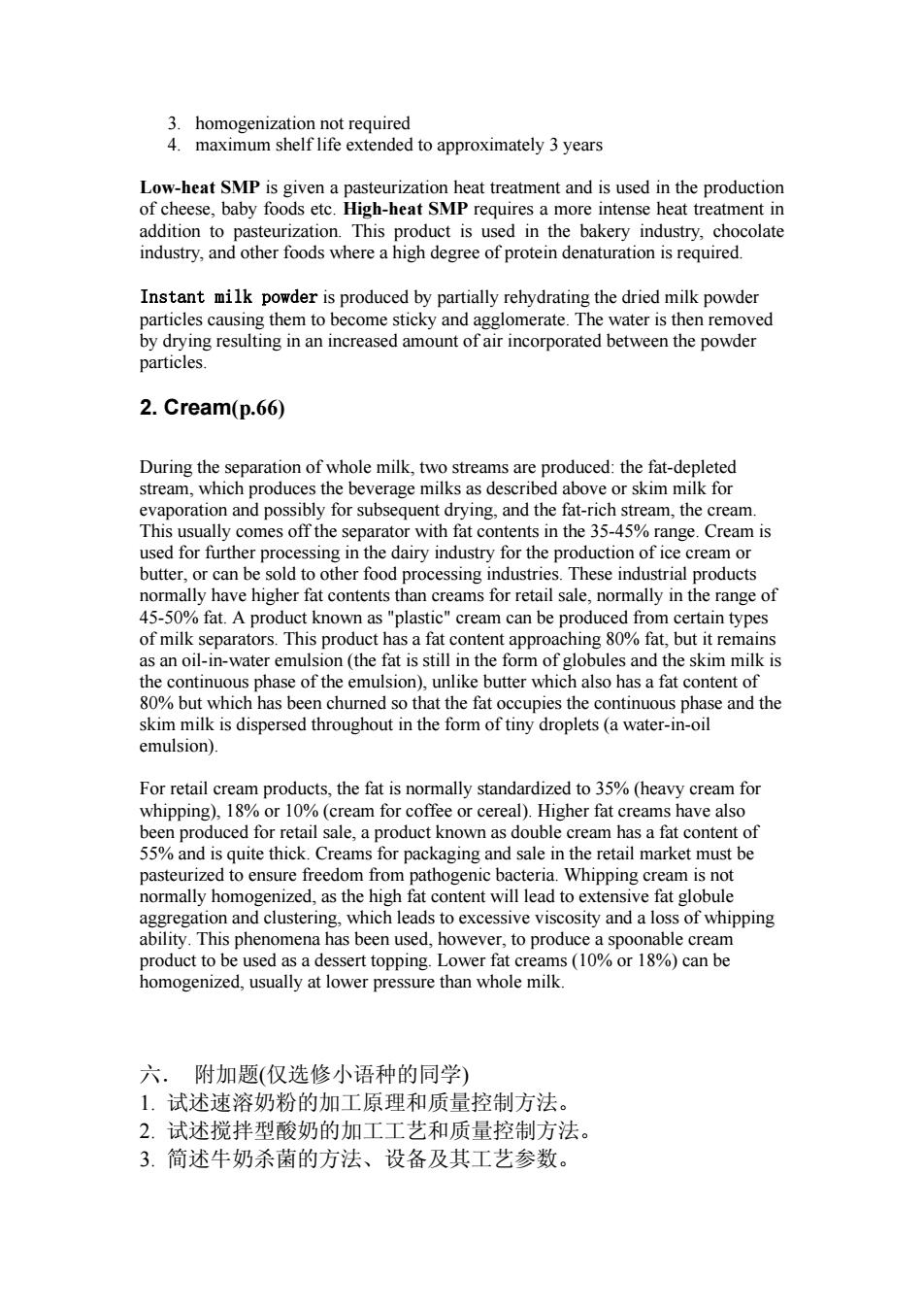
说明: 1允许使用中英文字典。 2.原则上,中文题用中文回答,英文题用英文回答 3.选修小语种的同学可不做英语题,但须作附加题。 试题2005 一、填空(每小题0.5分,共计6分。其中,中英文各选填6题) 1.Dairy Pro essing includes on,Standardization Pasteurizat UHT Tr atm and Dehydration. Productio nd Utilization of Steam 、名词解释 1.SMP :Skim milk powder (p.70) 2 IHT.ultra-high 48 三、简述题(每小题7.0分,共计42分。其中,中英文各3题) 1.How to Separate the cream from milk?(p.39) Centrifuges can be used to separate the cream from the skim milk.The centrifuge consists of up to 120 discs stacked together at a 45 to 60 degree angle and separated by a 0.4 to 2.0 mm gap or separation channel.Milk is introduced at the outer edge of the disc stack.The stack of discs has vertically aligned distribution holes into which the milk is introduced Under the the fat globules (cream) which are less dens rotatio Thnik illmove ouwarsan d the 2.How to standardize the milk?(p.40) The streams of skir and er nuet he combined to a specified fa ent This can b done by adi valve is co the throttling valv eof outlet if the pletely closed,all milk will be discharged through the skim milk outlet As the valve is progressively opened,larger amounts of cream with diminishing fat contents are discharged from the cream outlet with direct standardization the cream and skim are automatically remixed at the separator to provide the desired fat content Some basic standardization problems including mass balance and Pearson square approach can be viewed here. 3.What is the Continuous method of Pasteurization of milk?(p.42) Continuous process method has several advantages over the vat method,the most mportant being time and energy saving.For most continuous processing,a high temperature short time (HTST)pasteurizer Is used. The heat treatment is accomplished using a plate heat excha This piece of equipment consists of a stack of corrugatec stainless steel plates clamped together in a frame.There are
说明: 1. 允许使用中英文字典。 2. 原则上,中文题用中文回答,英文题用英文回答。 3. 选修小语种的同学可不做英语题,但须作附加题。 试题 2005 一、填空(每小题 0.5 分,共计 6 分。其中,中英文各选填 6 题) 1. Dairy Processing includes include Clarification, Separation, Standardization, Pasteurization, UHT Treatment , Homogenization, Membrane Processing, Evaporation and Dehydration, Production and Utilization of Steam and Refrigeration. 二、名词解释 1. SMP :Skim milk powder (p.70) 2. UHT: ultra-high temperature(p.48) 三、简述题(每小题 7.0 分,共计 42 分。其中,中英文各 3 题) 1. How to Separate the cream from milk?(p.39) Centrifuges can be used to separate the cream from the skim milk. The centrifuge consists of up to 120 discs stacked together at a 45 to 60 degree angle and separated by a 0.4 to 2.0 mm gap or separation channel. Milk is introduced at the outer edge of the disc stack. The stack of discs has vertically aligned distribution holes into which the milk is introduced. Under the influence of centrifugal force the fat globules (cream), which are less dense than the skim milk, move inwards through the separation channels toward the axis of rotation. The skim milk will move outwards and leaves through a separate outlet. 2. How to standardize the milk?(p.40) The streams of skim and cream after separation must be recombined to a specified fat content. This can be done by adjusting the throttling valve of the cream outlet; if the valve is completely closed, all milk will be discharged through the skim milk outlet. As the valve is progressively opened, larger amounts of cream with diminishing fat contents are discharged from the cream outlet. With direct standardization the cream and skim are automatically remixed at the separator to provide the desired fat content. Some basic standardization problems including mass balance and Pearson square approach can be viewed here. 3. What is the Continuous method of Pasteurization of milk?(p.42) Continuous process method has several advantages over the vat method, the most important being time and energy saving. For most continuous processing, a high temperature short time (HTST) pasteurizer is used. The heat treatment is accomplished using a plate heat exchanger. This piece of equipment consists of a stack of corrugated stainless steel plates clamped together in a frame. There are

several flow patterns that can be used.Gaskets are used to define the boundaries of the channels and to prevent leakage.The heating medium can be vacuum steam or hot water. 四、论述题 1.How can raw milk be homogenized?(p.52) Milk is an oil-in milk Ho ical tr of the fat globules in brought about by passing milk under high pr ere thro orifice which results in a decrease in the average diameter and an increase e in number and surface area,of the fat globules.The net result,from a practical view,is a much reduced tendency for creaming of fat globules.Three factors contribute to this enhanced stability of homogenized milk:a decrease in the mean diameter of the fat globules(a factor in Stokes Law),a decrease in the size distribution of the fat globules(causing the speed of rise to be similar for the majority of globules such that they don't tend to cluster during creaming),and an increase in density of the globules(bringing them closer to the continuous phase)oweing to the adsorption of a protein membrane.In addition,he ks down the cryo-globulin complex,which tends to ster glob using them to rise 五、英翻汉(20分 1.Milk Powder Milk used in the product of milk powders is first a heat on Besides destro ng all the atho ost of the s ead3g microorganisms,it also inactivates the enz me lip e which could cause lipolysis during storage. The milk is then evaporated prior to drying for the following reasons: less occluded air and longer shelf life for the powder viscosity increase leads to larger powder particles less energy required to remove part of water by evaporation:more economical Homogeniation maybe applied to crease the free fat content.Spray drying is the most use for producing n ilk powders After drying,the pov aged ion from mo r long periods (up to about 6 6 months)of time a t temperature Skim milk(SMP)processing is similar to that described above except for the following point 2 smilkfat(0.05-0.10%) prior to evaporat can be more or less severe
several flow patterns that can be used. Gaskets are used to define the boundaries of the channels and to prevent leakage. The heating medium can be vacuum steam or hot water. 四、论述题 1. How can raw milk be homogenized ?(p.52) Milk is an oil-in-water emulsion, with the fat globules dispersed in a continuous skimmilk phase. If raw milk were left to stand, however, the fat would rise and form a cream layer. Homogenization is a mechanical treatment of the fat globules in milk brought about by passing milk under high pressure through a tiny orifice, which results in a decrease in the average diameter and an increase in number and surface area, of the fat globules. The net result, from a practical view, is a much reduced tendency for creaming of fat globules. Three factors contribute to this enhanced stability of homogenized milk: a decrease in the mean diameter of the fat globules (a factor in Stokes Law), a decrease in the size distribution of the fat globules (causing the speed of rise to be similar for the majority of globules such that they don't tend to cluster during creaming), and an increase in density of the globules (bringing them closer to the continuous phase) oweing to the adsorption of a protein membrane. In addition, heat pasteurization breaks down the cryo-globulin complex, which tends to cluster fat globules causing them to rise. 五、英翻汉(20 分) 1. Milk Powder Milk used in the production of milk powders is first clarified, standardized and then given a heat treatment. This heat treatment is usually more severe than that required for pasteurization. Besides destroying all the pathogenic and most of the spoilage microorganisms, it also inactivates the enzyme lipase which could cause lipolysis during storage. The milk is then evaporated prior to drying for the following reasons: • less occluded air and longer shelf life for the powder • viscosity increase leads to larger powder particles • less energy required to remove part of water by evaporation; more economical Homogenization may be applied to decrease the free fat content. Spray drying is the most used method for producing milk powders. After drying, the powder must be packaged in containers able to provide protection from moisture, air, light, etc. Whole milk powder can then be stored for long periods (up to about 6 months) of time at ambient temperatures. Skim milk powder (SMP) processing is similar to that described above except for the following points: 1. contains less milkfat (0.05-0.10%) 2. heat treatment prior to evaporation can be more or less severe

3.homogenization not required 4.maximum shelf life extended to approximately 3 years Low-heat SMP is given a pasteurization heat treatment and is used in the production of cheese,baby foods etc.High-heat SMP requires a more intense heat treatment in addition to pasteurization This product is used in the bakery industry,chocolate industry,and other foods where a high degree of protein denaturation is required. Instant ilk powder is produced by partially rehydrating the dried milk powder The water is then removed pan inereasedmoun ofinorporaed between the powder 2.Cream(p.66) During the separation of whole milk,two streams are produced:the fat-depleted stream,which produces the beverage milks as described above or skim milk for evaporation and possibly for subsequent drying,and the fat-rich stream,the cream 45%range.Cream is er processing in the dairy industry for the prod uctio ce cream or butter can b to other foo processing hese products 450l e highe an creams for ret sal normally in th range of fat.A prod known as am can be prod certam type mil parators (the fati till in th of th unlik a has fat o phase and the emulsion). For retail cream products,the fat is normally standardized to 35%(heavy cream for whipping),18%or 10%(cream for coffee or cereal).Higher fat creams have also been produced for retail sale,a product known as double cream has a fat content of 55%and is quite thick.Creams for packaging and sale in the retail market must be pasteurized to ensure freedom from pathogenic bacteria.Whipping cream is not normally homogenized.as theh igh fat content will lead to extens ve fat globule clustering,which exces ve vIs sity and a los s of whipping s phe enomena has been used, nowever,to produ ssert topping. (o can t lower pressure than whol 六.附加题(仅选修小语种的同学) 1.试述速溶奶粉的加工原理和质量控制方法 2.试述搅拌型酸奶的加工工艺和质量控制方法。 3.简述牛奶杀菌的方法、设备及其工艺参数
3. homogenization not required 4. maximum shelf life extended to approximately 3 years Low-heat SMP is given a pasteurization heat treatment and is used in the production of cheese, baby foods etc. High-heat SMP requires a more intense heat treatment in addition to pasteurization. This product is used in the bakery industry, chocolate industry, and other foods where a high degree of protein denaturation is required. Instant milk powder is produced by partially rehydrating the dried milk powder particles causing them to become sticky and agglomerate. The water is then removed by drying resulting in an increased amount of air incorporated between the powder particles. 2. Cream(p.66) During the separation of whole milk, two streams are produced: the fat-depleted stream, which produces the beverage milks as described above or skim milk for evaporation and possibly for subsequent drying, and the fat-rich stream, the cream. This usually comes off the separator with fat contents in the 35-45% range. Cream is used for further processing in the dairy industry for the production of ice cream or butter, or can be sold to other food processing industries. These industrial products normally have higher fat contents than creams for retail sale, normally in the range of 45-50% fat. A product known as "plastic" cream can be produced from certain types of milk separators. This product has a fat content approaching 80% fat, but it remains as an oil-in-water emulsion (the fat is still in the form of globules and the skim milk is the continuous phase of the emulsion), unlike butter which also has a fat content of 80% but which has been churned so that the fat occupies the continuous phase and the skim milk is dispersed throughout in the form of tiny droplets (a water-in-oil emulsion). For retail cream products, the fat is normally standardized to 35% (heavy cream for whipping), 18% or 10% (cream for coffee or cereal). Higher fat creams have also been produced for retail sale, a product known as double cream has a fat content of 55% and is quite thick. Creams for packaging and sale in the retail market must be pasteurized to ensure freedom from pathogenic bacteria. Whipping cream is not normally homogenized, as the high fat content will lead to extensive fat globule aggregation and clustering, which leads to excessive viscosity and a loss of whipping ability. This phenomena has been used, however, to produce a spoonable cream product to be used as a dessert topping. Lower fat creams (10% or 18%) can be homogenized, usually at lower pressure than whole milk. 六. 附加题(仅选修小语种的同学) 1. 试述速溶奶粉的加工原理和质量控制方法。 2. 试述搅拌型酸奶的加工工艺和质量控制方法。 3. 简述牛奶杀菌的方法、设备及其工艺参数

4.简述发酵剂的质量鉴定方法及其标准 5.为什么牛奶的酸度是用T度而不用pH表示? 6.试举一例说明发酵成熟奶酪的加工工艺和质量控制方法。 5.名词解释(每小题2分,共计6分) 5.名词解释 (1)T度 (2)UHT (3)酸奶的后发酵 分数分布 1.论述题(30分,3题,中文2题,英文1题) 2.英翻汉(20分) 3.简述题(40分,8题,中英文个4题) 4.名词解释(4分,4题,中英文各2题) 5.填空(6分,12题,中英文各6题)
4. 简述发酵剂的质量鉴定方法及其标准 5. 为什么牛奶的酸度是用 T 度而不用 pH 表示? 6. 试举一例说明发酵成熟奶酪的加工工艺和质量控制方法。 5. 名词解释(每小题 2 分,共计 6 分) 5. 名词解释 (1) T 度 (2) UHT (3) 酸奶的后发酵 分数分布 1. 论述题(30 分,3 题,中文 2 题,英文 1 题) 2. 英翻汉(20 分) 3. 简述题(40 分,8 题,中英文个 4 题) 4. 名词解释(4 分,4 题,中英文各 2 题) 5. 填空(6 分,12 题,中英文各 6 题)